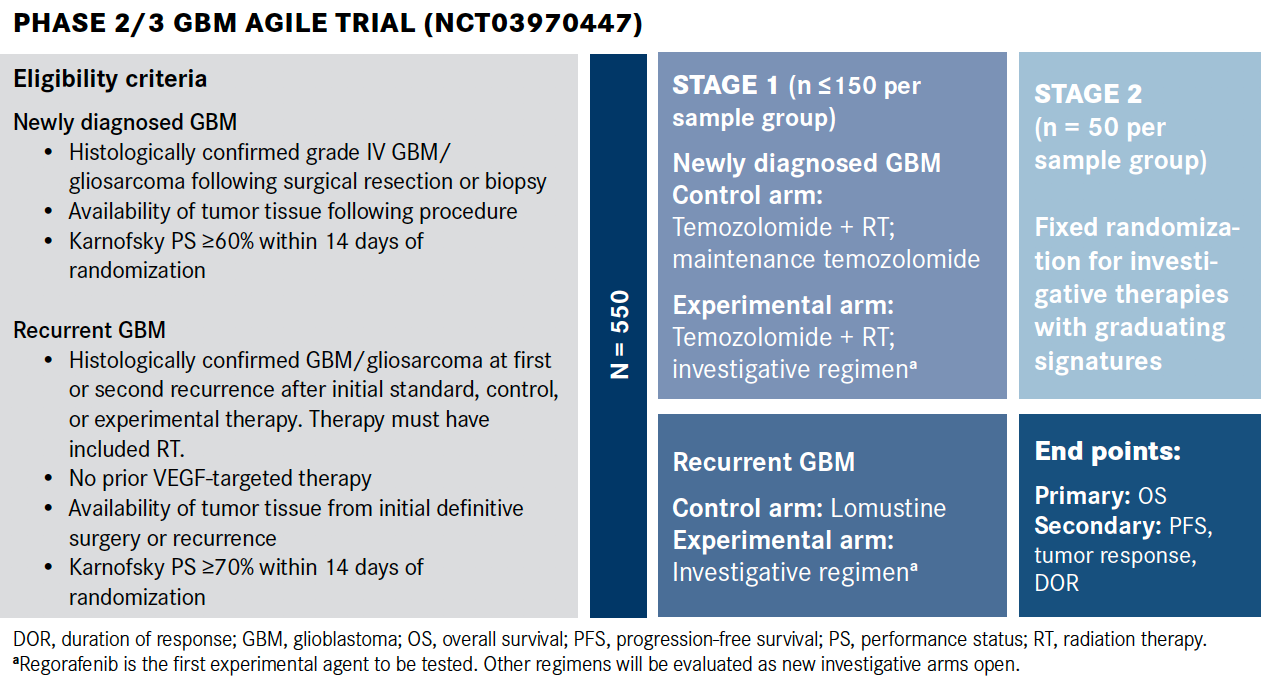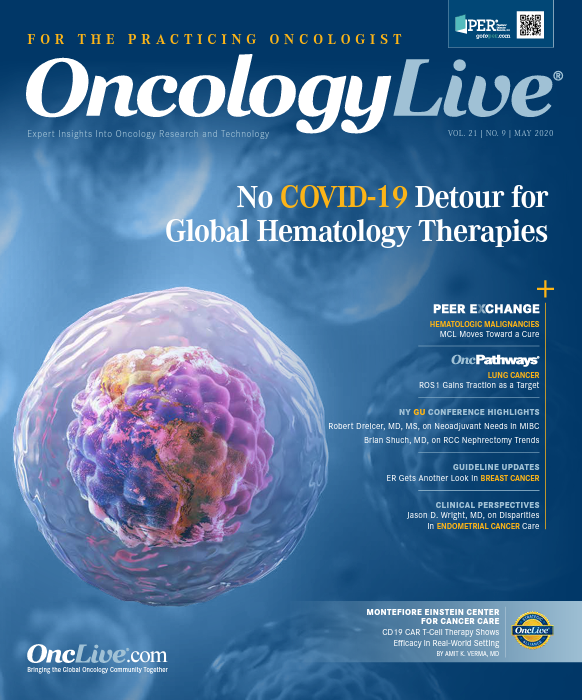Publication
Article
Oncology Live®
Chasing a Cure for GBM: Investigators Test Multiple Regimens in Novel Trial
Author(s):
Investigators of the first global adaptive phase 2/3 GBM Adaptive Global Innovative Learning Environment platform trial are implementing a multiarm, 2-stage approach to concurrently evaluate single-agent and combination regimens in glioblastoma.
Timothy F. Cloughesy, MD

Investigators are changing the standard randomized controlled trial (RCT) design to more expeditiously identify experimental therapies for patients with glioblastoma (GBM), the deadliest form of brain cancer.1
GBM kills 95% of patients within 5 years of diagnosis, with more than half of patients dying in the first 15 months; that prognosis makes a customary RCT structure that could span 1 to 4 years in length impractical. Investigators of the first global adaptive phase 2/3 GBM Adaptive Global Innovative Learning Environment (AGILE) platform trial (NCT03970447) are implementing a multiarm, 2-stage approach to concurrently evaluate single-agent and combination regimens.1,2
“We felt that there needed to be a way to test multiple therapies in a randomized study, determine whether or not there are signals, confirm those signals, and move forward with new drug applications,” said Timothy F. Cloughesy, MD, global principal investigator of the GBM AGILE trial and director of the Neuro-Oncology Program of the Brain Research Institute at the University of California, Los Angeles.
GBM AGILE is recruiting 550 patients with IDH1 R132H wild-type newly diagnosed (ND) grade IV GBM or recurrent GBM (Figure). Investigators will stratify patients by 3 subtypes of GBM: ND methylated GBM, ND unmethylated GBM, or recurrent disease, and randomize them to a treatment arm in the trial’s first stage.
At present, GBM AGILE investigators are evaluating treatment interventions in patients either with ND unmethylated GBM or recurrent disease.
Patients with ND GBM who are randomized to the control arm will receive radiation therapy (RT) at 60 Gy in combination with temozolomide (Temodar) at 75 mg/m2 for 6 weeks, followed by maintenance temozolomide. The maintenance phase would begin 2 to 6 weeks after RT, starting with 150 mg/m2 on days 1 to 5 of a 28-day cycle, followed by 200 mg/m2 on days 1 to 5 of the second and subsequent cycles. In the experimental arm, patients with ND GBM will also be treated with RT and temozolomide but will receive the experimental regimen instead of maintenance temozolomide.
Figure. Multiple Regimens in Newly Diagnosed and Recurrent GBM Study

For those with recurrent disease, participants in the control arm will be treated with lomustine (Gleostine) started at 110 mg/m2 per day on day 1 of a 42-day cycle for a maximum of 6 cycles; in the experimental arm, patients with recurrent disease type will receive an investigtional therapy.
The first experimental agent to be tested is regorafenib (Stivarga), a multikinase inhibitor that the FDA has approved for metastatic colorectal cancer, metastatic gastrointestinal stromal tumor, and hepatocellular carcinoma. In the GBM AGILE trial, regorafenib will be administered at 160 mg daily for 3 weeks of every 4-week cycle.
As the study progresses, investigators will open additional treatment arms to explore other regimens. They also will assess patients for potential biomarkers that could be used to direct therapy. Across stages 1 and 2 of GBM AGILE, the primary end point of the study is overall survival (OS). Secondary end points include progression-free survival, tumor response, and duration of response.
Tailoring Trial to the Disease
GBM AGILE investigators will closely assess the anticancer activity of the control and experimental interventions in the ND and recurrent disease populations. In stage 1 of the study, investigators will stop enrolling patients in a treatment arm if the arm completes accrual (n ≤150) or if the arm’s therapy demonstrates futility or unacceptable toxicity.3
In stage 1 of the GBM AGILE study, investigators will use a dynamic assignment strategy known as adaptive randomization to direct a higher proportion of new participants to the superior treatment arm.4
“Adaptive randomization allows us to identify the therapies that are working best for patients. The randomization probabilities would adjust based on current data from the ongoing trial,” Cloughesy said.
This predefined algorithm will identify the treatments with the greatest efficacy based on the survival benefit that these therapies confer when compared with a common control. It will also select the GBM population for which these interventions are most promising. Those therapies deemed promising will “graduate” to stage 2.1
For this stage, investigators will use fixed randomization to evaluate the efficacy of these therapies in the algorithm-defined population to confirm findings from the first stage of the trial. Each stage 2 cohort will enroll 50 patients.3,4
The design of the 2-stage study supports swifter patient registration, as well as a more rapid regulatory review process and subsequent clinical adoption of the treatments that display signals in the second stage of the GBM AGILE study.4
Equally important, GBM AGILE’s unique model means that investigators can more rapidly identify and expel the treatments that do not show signals indicative of therapeutic benefit than they would in traditional RCTs. “[Recognizing] early futility has huge value because if you find early futility and stop enrollment, you have determined that the therapy is not going to confer benefit, and you didn’t have to run a large, costly phase 3 study to get that answer,” Cloughesy said.
Of note, data from the treatments that do not demonstrate a sufficient survival advantage in the first stage to justify further study in stage 2, but nevertheless suggest a potential benefit, will become available to GBM specialists and can be used to support the development of biomarker hypotheses as well as further therapeutic investigations in the field.4
“Our goal is to identify the effective drugs, get rid of the ineffective drugs, and also identify the drugs that have a signal, [but one] that isn’t quite as strong [as others],” Cloughesy said, adding that drug developers can draw upon data from the GBM AGILE study to determine whether they would like to appropriately power and pursue a trial of an agent that was found to have a more minimal signal in the phase 2/3 study.
Pursuing Paradigm Change
The GBM AGILE study is a clinical endeavor that has been years in the making and owes its dynamic design to the collaborative interplay of more than 130 oncologists, pathologists, statisticians, imagers, neurosurgeons and academic, industry, and government researchers, who have worked collectively to cultivate this investigative model since 2015.1
GBM AGILE is a “group effort” that was initiated in response to a series of unsuccessful clinical trials in GBM, according to Cloughesy. “The rationale for GBM AGILE comes from the setting of GBM, where in the [past] few years, there have been several negative phase 3 studies. They were expensive, costing several hundred million dollars, and it seemed that we weren’t [facilitating investigations] very well,” Cloughesy said. “Then, the disease gets the reputation that drugs can’t be developed in glioblastoma— that they’re just bound to fail.”
In ND GBM, the standard of care is temozolomide, which was approved for use in combination with RT and as a maintenance therapy in 2005.5 Existing data show that the median OS with temozolomide and concurrent RT is 14.6 months versus 12.1 months with RT alone, supporting the doublet regimen’s application in this setting.6
Patients with ND GBM receive temozolomide with RT after maximal surgical resection, which rarely eradicates GBM tumor cells in their totality due to the invasive nature of the disease. Although adjuvant temozolomide and RT are administered to reduce the risk of disease recurrence, nearly all cases of GBM that initially respond to frontline treatment eventually recur.1,7
In contrast to ND GBM, there is no established standard of care for recurrent disease. Interventions for recurrent GBM can include surgical resection, reirradiation, nitrosoureas, temozolomide rechallenge, or treatment with tyrosine kinase inhibitors or bevacizumab (Avastin).7
Bevacizumab was indicated for use in patients with GBM in 2017, after findings from the phase 3 EORTC 26101 study (NCT01290939) showed that adding the VEGF inhibitor to lomustine reduced the risk of disease progression or death by 48%.8 Administering bevacizumab with lomustine extended the median progression- free survival versus single-agent lomustine (4.2 vs 1.5 months; HR, 0.52; 95% CI, 0.41-0.64) but notably did not result in a significant improvement in OS (HR, 0.91; P = .4578).9
The modest survival benefits that existing therapies afford patients with GBM, coupled with the lack of curative options, translate to a need for more efficacious treatment options for a disease that accounts for 45% of all malignant brain tumors and more than 12,000 cases annually in the United States.1
Leading a Movement in GBM
GBM AGILE investigators and the trial’s broad network of clinical collaborators believe that the platform format of the study has the potential to not only identify better therapies for this deadly disease but also reduce the time and costs associated with their development around the world.
“We wanted to facilitate this evaluation in 1 environment to boost development in glioblastoma, and we also wanted to do this in multiple jurisdictions beyond the United States,” Cloughesy said. GBM AGILE is actively enrolling patients in the United States, and international locations in Canada, China, and Europe are also expected to open at a later date, according to Cloughesy.
Whereas the coronavirus disease 2019 (COVID-19) pandemic has prompted the suspension of many clinical trials across the nation, GBM AGILE has continued to accrue patients. “We have continued to add sites during this time and enrollment has remained steady, so we’ve been happy to see that,” Cloughesy said. “At their institutions, people [ask], what’s a necessary study going forward? Glioblastoma is almost 100% fatal. COVID-19 is incredibly serious, but glioblastoma will continue to be serious even after we’ve learned how to deal with COVID-19. We still need to learn how to deal with glioblastoma.”
References:
- Global Coalition For Adaptive Research. GBM AGILE website. Accessed April 13, 2020. bit.ly/2RU55M2
- Step 3: clinical research. US FDA website. Updated January 4, 2018. Accessed April 14, 2020. bit.ly/2KrezKs
- A trial to evaluate multiple regimens in newly diagnosed and recurrent glioblastoma (GBM AGILE). ClinicalTrials.gov identifier: NCT03970447. Updated April 14, 2020. Accessed April 15, 2020. http://www.clinicaltrials.gov/ct2/show/NCT03970447 Alexander BM, Ba Sujuan, Berger MS, et al. Adaptive global innovative learning environment for glioblastoma: GBM AGILE. Clin Cancer Res. 2018;24(4):737-743. doi:10.1158/1078-0432.CCR-17-0764
- Alexander BM, Ba Sujuan, Berger MS, et al. Adaptive global innovative learning environment for glioblastoma: GBM AGILE. Clin Cancer Res. 2018;24(4):737-743. doi:10.1158/1078-0432.CCR-17-0764
- Temodar. Package insert. Merck; 2019. Accessed April 15, 2020. https://www.accessdata.fda.gov/drugsatfda_docs/label/2019/021029s033lbl.pdf
- Stupp R, Mason WP, van dan Bent MJ, et al. Radiotherapy plus concomitant and adjuvant temozolomide for glioblastoma. N Engl J Med. 2005;352:987-996. doi:10.1056/NEJMoa043330
- Shergalis A, Bankhead A, Luesakul U, Muangsin N, Neamati N. Current challenges and opportunities in treating glioblastoma. Pharmacological Reviews. 2018;70(3):412-445. doi:10.1124/pr.117.014944
- Avastin. Package insert. Genentech Inc; 2019. Accessed April 15, 2020. https://www.accessdata.fda.gov/drugsatfda_docs/label/2019/125085s331lbl.pdf
- Wick W, Gorlia T, Bendszus M, et al. Lomustine and bevacizumab in progressive glioblastoma. N Engl J Med. 2017;377(20):1954-1963. doi:10.1056/NEJMoa1707358





























%20(2)%201-Recovered-Recovered-Recovered-Recovered-Recovered-Recovered-Recovered-Recovered-Recovered-Recovered-Recovered-Recovered-Recovered-Recovered-Recovered-Recovered-Recovered.jpg?fit=crop&auto=format)
%20(2)%201-Recovered-Recovered-Recovered-Recovered-Recovered-Recovered-Recovered-Recovered-Recovered-Recovered-Recovered-Recovered-Recovered-Recovered-Recovered-Recovered-Recovered.jpg?fit=crop&auto=format)
